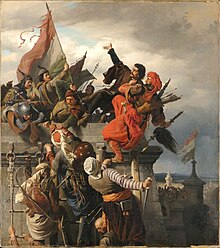Ottoman–Hungarian Wars
| Ottoman–Hungarian Wars | |||||||
|---|---|---|---|---|---|---|---|
 Hungarian defenders in Belgrade (1456) part of the Ottoman Wars in Europe |
|||||||
|
|||||||
| Belligerents | |||||||
|
|
|
||||||
| Commanders and leaders | |||||||
|
|
|
||||||
| Strength | |||||||
| ~20,000–60,000 | Capable of raising 100,000 men | ||||||
![]() Ottoman Empire
Ottoman Empire
Vassal:
The Ottoman–Hungarian Wars were a series of battles between the Ottoman Empire and the medieval Kingdom of Hungary. Following the Byzantine Civil War, the Ottoman capture of Gallipoli and the decisive Battle of Kosovo, the Ottoman Empire seemed poised to conquer the whole of the Balkans. However, the Ottoman invasion of Serbia drove Hungary to war against the Ottomans, competing for the vassalship of the states of Serbia, Wallachia and Moldavia.
Initial Hungarian success culminated in the Crusade of Varna, though without significant outside support the Hungarians were defeated. Nonetheless the Ottomans suffered more defeats at Belgrade, even after the conquest of Constantinople. In particular, the infamous Vlad the Impaler who, with limited Hungarian help, resisted Ottoman rule until the Ottomans placed his brother, a man less feared and less hated by the populace, on the throne of Wallachia. Ottoman success was once again halted at Moldavia due to Hungarian intervention, but the Turks finally succeeded when Moldavia and then Belgrade fell to Bayezid II and Suleiman the Magnificent, respectively. In 1526 the Ottomans crushed the Hungarian army at Mohács with King Louis II of Hungary perishing along with 14,000-20,000 of his foot soldiers. Following this defeat, the eastern region of the Kingdom of Hungary (mainly Transylvania) became an Ottoman tributary state, constantly engaged in civil war with Royal Hungary. The war continued with the Habsburgs now asserting primacy in the conflict with Suleiman and his successors. The northern parts of Hungary managed to remain free from Ottoman rule, but the Kingdom of Hungary, the most powerful state east of Vienna under Matthias II, was now divided and constantly threationed by Ottoman ambitions in the region.
...
Wikipedia
